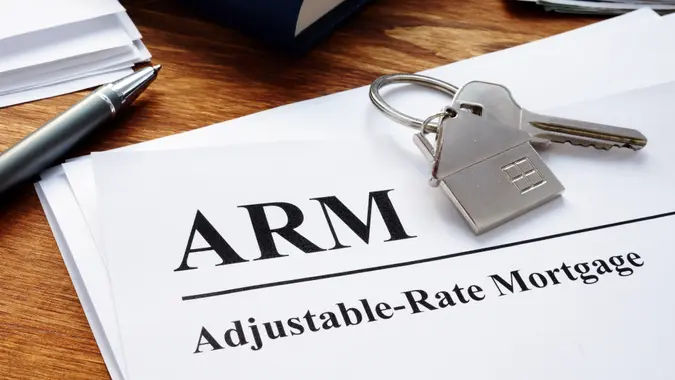FHA vs. Conventional Loans: Pros, Cons, and Which To Choose

Commitment to Our Readers
GOBankingRates' editorial team is committed to bringing you unbiased reviews and information. We use data-driven methodologies to evaluate financial products and services - our reviews and ratings are not influenced by advertisers. You can read more about our editorial guidelines and our products and services review methodology.

20 Years
Helping You Live Richer

Reviewed
by Experts

Trusted by
Millions of Readers
If you’re looking to purchase a home, you have a few loan options. Two common ones are Federal Housing Administration mortgage loans and conventional mortgages.
Whereas FHA loans are backed by the U.S. government to protect lenders against borrower default, conventional loans are backed by Fannie Mae or Freddie Mac — government-sponsored enterprises that purchase the loans to free lenders to make more loans.
What Is an FHA Loan and How Is It Different From Other Mortgages?
FHA loans are government-backed loans insured by the U.S. Federal Housing Administration and offered by private lenders. The insurance enables lenders to relax some qualifying criteria for borrowers. That makes FHA loans especially well-suited for first-time homebuyers and those with lower credit scores and lower income than they might need to qualify for conventional loans.
In addition to being relatively easy to qualify for, FHA loans let borrowers purchase homes as little as 3.5% down. The downside is that borrowers must pay mortgage insurance premiums for at least 11 years and for as long as the life of the loan, no matter how much equity they have.
What Is a Conventional Loan?
Like FHA loans, conventional loans are offered by private lenders. However, lenders sell most conventional loans to Fannie Mae or Freddie Mac, which have stricter eligibility requirements for loans they purchase compared to the FHA’s requirements for the loans they insure. You’ll need a higher credit score, for example, and a lower debt-to-income ratio.
Conventional loan borrowers only have to pay mortgage insurance if they have less than 20% equity. However, you can finance a home with as little as 5% down — and 3% if you’re a first-time buyer. You also have more flexibility with the properties you can finance.
A conventional loan conforms to Fannie Mae and Freddie Mac guidelines rather than guidelines from the FHA or another government agency.
Conventional loans are the most popular type of mortgage loan.
Key Differences Between FHA and Conventional Loans
FHA and conventional loans differ in important ways.
Credit Score Requirements
Both loan types have minimum credit score requirements. FHA allows a credit score as low as 500 if you put 10% down, or a score of 580 with 3.5% down. Conventional loans, on the other hand, require a credit score of at least 620.
It’s important to note that while minimum scores are the very least the FHA and Fannie Mae or Freddie Mac allow, they don’t guarantee loan approval. Average credit scores for both loan types are significantly higher than the minimums.
Debt-to-Income Requirements
FHA loans allow a higher debt-to-income ratio: up to 50% if your credit score is at least 580, compared to a conventional loan’s maximum 45% with a 680 credit score and at least 25% down.
Down Payment Requirements
The minimum down payment allowed with an FHA loan is 3.5% with a credit score of 580, and 10% with a credit score of 500 to 579. Standard conventional loans allow a minimum of 5%, or 3% for certain loans for first-time buyers.
Mortgage Insurance
With an FHA mortgage, you have an annual mortgage insurance premium, payable in monthly installments with your mortgage payment, for 11 years with a down payment of at least 10% — or the life of the loan with a smaller down payment. In addition, you pay an upfront fee of 1.75% of the loan amount when you get the loan.
With conventional loans, if you have private mortgage insurance, you can ask the lender to discontinue it once you have 20% equity. The lender removes it automatically when the loan-to-value ratio reaches 78%, which means 22% equity.
Loan Limits
FHA and conventional mortgage loans both have limits on how much you can borrow. The limits vary by location, called areas, and are based on median home prices in each area. In 2025, FHA’s “floor limit” for single-family homes in lower-priced areas is $524,225. Its ceiling limit, for high-priced areas, is $1,209,750.
The baseline for conventional loans is $806,500 for 2025. The ceiling limit is 150% of base line: $1,209,750. Alaska, Hawaii, Guam and the U.S. Virgin Islands have their own baseline of $1,209,750. Loans that fall within these limits are called conforming loans.
Occupancy Requirements
You can finance a one-to-four unit home with either loan type, but you’ll have to live in one of the units as your primary residence if you finance the property with an FHA loan. Outside of special programs for first-time borrowers, conventional loans don’t have an occupancy requirement — you can use one to purchase a primary home, second home or investment property.
Property Standards
Conventional loans also allow more flexibility when it comes to the condition of a home you can finance. The property must be “safe, sound and structurally secure,” accessible by road and suitable for year-round use. The lender’s appraisal flags properties that don’t meet these standards.
FHA loans also require an appraisal, but it’s a special type for government-backed loans that includes an inspection to make sure the home meets the FHA’s minimum standards for quality and habitability.
Whereas some conventional loan appraisals don’t even require the appraiser to get out of the car, FHA appraisers walk through the home and property to look for safety and other quality issues. However, the appraisal doesn’t replace a home inspection — you’ll still need to hire a licensed inspector to do a thorough home inspection for a detailed look at the home’s condition.
Refinancing Options
If you want to refinance your loan later, you’re not confined to refinancing an FHA loan into another FHA loan or a conventional loan into another conventional loan. FHA borrowers often refinance into conventional loans to eliminate mortgage insurance once they’ve built 20% equity in their homes. However, refinancing into the same type of loan can make a refinance faster and easier.
The FHA, for example, has a streamline refi that lets you refinance your existing FHA loan without having to go through the usual underwriting process.
Conventional loans don’t have a streamlined process, and the rates are usually slightly higher. You won’t have to pay mortgage insurance, though, as long as you don’t borrow more than 80% of the home’s value.
Rates
Lenders set their own rates for both loan types, but conventional loan rates are usually higher. FHA insurance reduces the lenders’ risk, so they can offer lower rates on those loans.
Pros and Cons of FHA vs. Conventional Loans
Here’s an at-a-glance look at how the two loan types compare.
| Feature | FHA Loan | Conventional Loan |
|---|---|---|
| Credit score Requirement | 580 for 3.5% down; 500 – 579 requires 10% down | 620 or higher |
| Debt-to-income requirement | Up to 50% if your credit score is at least 580 | Up to 45% with a 680 credit score and at least 25% down |
| Down payment requirement | 3.5% with credit score of 580 or more; 10% down with credit score of 500 to 579 | -5% -3% for special programs for first-time borrowers |
| Mortgage insurance | Upfront and annual premium, paid monthly, for 11 or years or life of loan | Required for loan-to-value ratios higher than 80% |
| Loan limits | Varies by location, lower than conventional limits | Varies by location, higher than FHA limits |
| Occupancy requirements | Borrower occupancy required | Borrower occupancy not required |
| Property standards | Stricter standards for safety and condition | Less stringent |
| Refinance options | Streamline refi available | No streamline option |
| Rates | Typically lower than conventional rates | Typically higher than FHA rates |
| Best for | First-time buyers, buyers with lower credit scores and higher DTIs | Borrowers with credit scores of at least 620, especially with a 20% down payment |
How To Decide Which Loan Is Right for You
The differences between FHA and conventional loans can cost or save you a lot of money, so it’s important to weigh your options carefully.
Choose an FHA loan if:
- Your credit score is below 620
- You have limited savings for a down payment.
Choose a conventional loan if:
- You have a credit score of 620 or higher
- You can put down 20% or more to avoid PMI.
Barri Segal contributed to the reporting for this article.
Our in-house research team and on-site financial experts work together to create content that’s accurate, impartial, and up to date. We fact-check every single statistic, quote and fact using trusted primary resources to make sure the information we provide is correct. You can learn more about GOBankingRates’ processes and standards in our editorial policy.
- U.S. Department of Housing and Urban Development. "About Us."
- Federal Housing Finance Agency. "About Fannie Mae & Freddie Mac."
- U.S. Department of Housing and Urban Development. "FHA Single Family Housing Policy Handbook."
- QuickenLoans. "FHA Vs. Conventional Loan: What’s The Difference?"
- Fannie Mae. "97% Loan to Value Options."
- Experian. 2024. "What Type of Mortgage Loan Is Best?"
- Freddie Mac. "Automatic cancelation of Borrower-paid mortgage insurance on an HPA Mortgage."
- U.S. Department of Housing and Urban Development. "Maximum Mortgage Limits 2025."
- FHFA. "FHFA Announces Conforming Loan Limit Values for 2025."
- Fannie Mae. "Selling Guide."
- U.S. Department of Housing and Urban Development. "Streamline Your FHA Mortgage."
 Written by
Written by  Edited by
Edited by 























